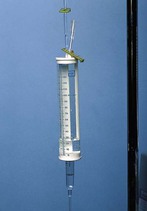Skill 54
Peripheral Intravenous Care
Regulating Intravenous Flow Rate, Changing Tubing and Solution
Appropriate regulation of fluid rates reduces complications associated with intravenous (IV) therapy (INS Policy and Procedures, 2011). Changes in patient position, flexion of the IV site extremity, and occlusion of the IV device influence infusion rates. A patient achieves therapeutic outcomes and fewer complications when the IV system and flow rate are assessed systematically (Alexander et al., 2010).
Electronic infusion devices (EIDs) maintain correct flow rates and catheter patency and prevent an unexpected bolus of IV infusion. Diligence is necessary on your part to assess and monitor patients because use of any EID or controller is not without the risk of malfunction, placing a patient at risk for harm or injury.
Non-EIDs such as a volume-control device deliver small fluid volumes with the aid of gravity. One example of a volume-control device is a calibrated chamber placed between the IV container and the insertion spike and drip chamber of an administration set (Fig. 54-1).
Administration sets used for parenteral nutrition and blood or blood products have specific criteria with which you need to be familiar when administering these advanced therapies (see agency policy). Whenever possible, schedule tubing changes when it is time to hang a new IV container. If the tubing becomes damaged, is leaking, or becomes contaminated, it must be changed, regardless of the tubing change schedule.
Patients receiving intravenous (IV) therapy over time require periodic changes of IV solutions. You change a container when there is an order for a new solution or when it becomes time to add a sequential container to avoid exceeding hang time (Alexander et al., 2010).
Delegation Considerations
The skill of regulating IV flow rate, changing infusion tubing, or changing an IV solution cannot be delegated to nursing assistive personnel (NAP). Delegation to licensed practical nurses (LPNs) varies by state Nurse Practice Act. The nurse instructs the NAP to:
▪ Inform the nurse when the EID alarm signals.
▪ Inform the nurse when the fluid container is near completion or empty.
▪ Report any patient complaints of discomfort related to infusion such as pain, burning, bleeding, or swelling.
▪ Report to the nurse any leakage from or around the IV tubing.
▪ Report if tubing has become contaminated (e.g., lying on the floor).




